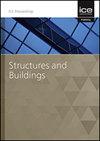Modelling bond in concrete with steel and carbon-fibre-reinforced-polymer composite bars
IF 1.4
4区 工程技术
Q3 CONSTRUCTION & BUILDING TECHNOLOGY
Proceedings of the Institution of Civil Engineers-Structures and Buildings
Pub Date : 2023-01-16
DOI:10.1680/jstbu.22.00090
引用次数: 0
Abstract
Understanding the bonding stress distribution and reinforcement strain distribution between steel and carbon-fibre-reinforced-polymer composite bars and concrete is essential to the design of concrete reinforced with such bars. Currently, the bond stress and reinforcement strain distribution patterns are not clear. Therefore, a series of pull-out tests was undertaken on concrete reinforced with steel and carbon-fibre-reinforced-polymer composite bars, carbon-fibre-reinforced-polymer bars and steel bars. With the help of a fibre Bragg grating sensing technology, the reinforcement strain and bonding stress distribution was studied. The results showed that for all specimens, the bond stress between the reinforcement and concrete was neither uniformly distributed nor reduced linearly along the bond length. For the steel and fibre-reinforced-polymer composite reinforcement, the steel core strain value was less than the carbon fibre strain value at the same position. Based on the test results, a bonding stress model and bond stress distribution model were established. The two models agreed well with the test data and can be used to predict bond stress and bond stress distribution.模型粘结混凝土与钢和碳纤维增强聚合物复合棒
了解钢和碳纤维增强聚合物复合钢筋与混凝土之间的粘结应力分布和钢筋应变分布对钢筋加固混凝土的设计具有重要意义。目前,粘结应力和钢筋应变的分布规律尚不清楚。为此,对钢筋与碳纤维增强聚合物复合筋、碳纤维增强聚合物筋和钢筋加固混凝土进行了一系列的拉拔试验。利用光纤光栅传感技术,对钢筋应变和粘结应力分布进行了研究。结果表明:在所有试件中,钢筋与混凝土之间的粘结应力既不均匀分布,也不沿粘结长度线性减小;对于钢和纤维增强-聚合物复合增强,在相同位置,钢芯应变值小于碳纤维应变值。根据试验结果,建立了粘结应力模型和粘结应力分布模型。两种模型与试验数据吻合较好,可用于预测粘结应力和粘结应力分布。
本文章由计算机程序翻译,如有差异,请以英文原文为准。
求助全文
约1分钟内获得全文
求助全文
来源期刊
CiteScore
3.40
自引率
6.20%
发文量
61
审稿时长
12 months
期刊介绍:
Structures and Buildings publishes peer-reviewed papers on the design and construction of civil engineering structures and the applied research associated with such activities. Topics include the design, strength, durability and behaviour of structural components and systems.
Topics covered: energy conservation, people movement within and around buildings, strength and durability of steel and concrete structural components, and the behaviour of building and bridge components and systems

 求助内容:
求助内容: 应助结果提醒方式:
应助结果提醒方式:


